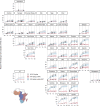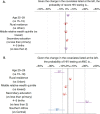Temporal Trends and Determinants of HIV Testing at Antenatal Care in Sub-Saharan Africa: A Pooled Analysis of Population-Based Surveys (2005-2021)
- PMID: 38180847
- PMCID: PMC10769174
- DOI: 10.1097/QAI.0000000000003329
Temporal Trends and Determinants of HIV Testing at Antenatal Care in Sub-Saharan Africa: A Pooled Analysis of Population-Based Surveys (2005-2021)
Abstract
Background: In sub-Saharan Africa (SSA), integrating HIV testing into antenatal care (ANC) has been crucial toward reducing mother-to-child transmission of HIV. With the introduction of new testing modalities, we explored temporal trends in HIV testing within and outside of ANC and identified sociodemographic determinants of testing during ANC.
Methods: We analyzed data from 139 nationally representative household surveys conducted between 2005 and 2021, including more than 2.2 million women aged 15-49 years in 41 SSA countries. We extracted data on women's recent HIV testing history (<24 months), by modality (ie, at ANC versus outside of ANC) and sociodemographic variables (ie, age, socioeconomic status, education level, number of births, urban/rural). We used Bayesian generalized linear mixed models to estimate HIV testing coverage and the proportion of those that tested as part of ANC.
Results: HIV testing coverage (<24 months) increased substantially between 2005 and 2021 from 8% to 38%, with significant variations between countries and subregions. Two percent of women received an HIV test in the 24 months preceding the survey interview as part of ANC in 2005 and 11% in 2021. Among women who received an HIV test in the 24 months preceding the survey, the probability of testing at ANC was significantly greater for multiparous, adolescent girls, rural women, women in the poorest wealth quintile, and women in West and Central Africa.
Conclusion: ANC testing remains an important component to achieving high levels of HIV testing coverage and benefits otherwise underserved women, which could prove instrumental to progress toward universal knowledge of HIV status in SSA.
Copyright © 2023 The Author(s). Published by Wolters Kluwer Health, Inc.
Figures




Similar articles
-
Determinants of non-testing for HIV among women during antenatal care follow up in sub-saharan Africa: a hierarchical analysis of recent Demographic and Health Survey datasets.BMC Health Serv Res. 2024 Dec 4;24(1):1542. doi: 10.1186/s12913-024-12035-3. BMC Health Serv Res. 2024. PMID: 39633365 Free PMC article.
-
Determinants of completing recommended antenatal care utilization in sub-Saharan from 2006 to 2018: evidence from 36 countries using Demographic and Health Surveys.BMC Pregnancy Childbirth. 2021 Mar 6;21(1):192. doi: 10.1186/s12884-021-03669-w. BMC Pregnancy Childbirth. 2021. PMID: 33676440 Free PMC article.
-
Socioeconomic inequalities in uptake of HIV testing during antenatal care: evidence from Sub-Saharan Africa.Int J Equity Health. 2024 Jan 8;23(1):4. doi: 10.1186/s12939-023-02068-1. Int J Equity Health. 2024. PMID: 38191394 Free PMC article.
-
Sero-prevalence of human immunodeficiency virus-hepatitis B virus (HIV-HBV) co-infection among pregnant women attending antenatal care (ANC) in sub-Saharan Africa (SSA) and the associated risk factors: a systematic review and meta-analysis.Virol J. 2020 Nov 7;17(1):170. doi: 10.1186/s12985-020-01443-6. Virol J. 2020. PMID: 33160386 Free PMC article.
-
[HIV prevalence in sub-Saharan Africa: background of an estimation].Med Sci (Paris). 2009 Jan;25(1):87-92. doi: 10.1051/medsci/200925187. Med Sci (Paris). 2009. PMID: 19154700 Review. French.
Cited by
-
Socio-demographic and geographic disparities in HIV prevalence, HIV testing and treatment coverage: An analysis of 108 national household surveys in 33 African countries.J Int AIDS Soc. 2025 Aug;28(8):e70024. doi: 10.1002/jia2.70024. J Int AIDS Soc. 2025. PMID: 40804796 Free PMC article.
-
Left Ventricular Changes and Inflammatory Biomarkers in HIV-Exposed Uninfected Infants in Jos, Northcentral Nigeria.Pediatr Cardiol. 2025 Aug 25. doi: 10.1007/s00246-025-03925-2. Online ahead of print. Pediatr Cardiol. 2025. PMID: 40853460
-
Updated Data and Methods for the 2023 UNAIDS HIV Estimates.J Acquir Immune Defic Syndr. 2024 Jan 1;95(1S):e1-e4. doi: 10.1097/QAI.0000000000003344. Epub 2024 Jan 4. J Acquir Immune Defic Syndr. 2024. PMID: 38180734 Free PMC article.
References
-
- Joint United Nations Programme on HIV/AIDS. UNAIDS Data 2021 [Internet]. UNAIDS; 2021. [cited April 22, 2023]. Available at: https://www.unaids.org/en/resources/documents/2021/2021_unaids_data.
-
- Joint United Nations Programme on HIV/AIDS. Global AIDS Strategy 2021–2026—End Inequalities. End AIDS [Internet]. UNAIDS; 2021. [cited April 22, 2023]. Available at: https://www.unaids.org/en/resources/documents/2021/2021-2026-global-AIDS....
-
- Ante-Testard PA, Benmarhnia T, Bekelynck A, et al. . Temporal trends in socioeconomic inequalities in HIV testing: an analysis of cross-sectional surveys from 16 sub-Saharan African countries. Lancet Glob Health. 2020;8:e808–e818. - PubMed
Publication types
MeSH terms
Grants and funding
LinkOut - more resources
Full Text Sources
Medical
Research Materials

